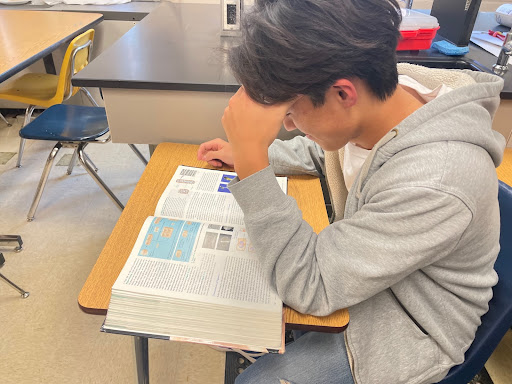Class rank: The competitive motivator

Fourth in the class of 2024 Jason Fang, studies for one of his AP classes. As class rank is determined by GPA, high-ranking students take many AP classes for the GPA boost.
In every class, there are hundreds of passionate students aiming for the top class ranks. However, people have mixed views on the class rank system and its impact on students. For some, class rank is another stressor that only adds to the pressure a student feels on themselves. For others, it is a motivator that drives them to success.
“Class rank is a way of showing how much you dedicate yourself to academics or what you are interested in,” Amy Yu (9) said. “If [some students] want to go to better colleges, they dedicate themselves more.”
Although some students see their class rank and think nothing of it, others actively chase the top spots. Their reasons for desiring the top spots vary on an individual level; some are simply driven to achieve highly in academia, some may be responding to parental pressure or some may associate high class rank with being accepted into acclaimed colleges. However, simple competition is often a reason for the chase.
“We have a percentage of students that are highly competitive in nature,” vice principal Michael Ayers said. “They strive to look for opportunities to push themselves and strive to be the best they can be and to be the highest rated student that they can be.”
Class rank does not simply function as an indicator of academic dedication for students alone; colleges also look at it to see where one ranks among one’s peers. While class rank isn’t considered as important as GPA, it still has its place on one’s transcript.
“I know that [class rank] is quite impactful — a lot of colleges look at it — especially if you are in the top one percent of your class,” Jason Fang (11) said. “I think it is just as important as an indicator as GPA is; [it’s] how you perform relative to your environment and peers.”
Some also see class rank as a motivator toward academic success. Many see their class rank as an indication of their effort and success in their schoolwork. Thus, a higher class rank signifies tremendous success. Claiming a particular position in the class ranks — whether it be top 100, top 50 or top 10 — can mean a great deal to some people. Students then naturally venerate higher ranks, which makes them want to reach them.
“I view it as motivation,” Fang said. “It could be scrapped, but I view it as motivation because I don’t want to fall too behind, and I feel like I want to ‘catch’ my peers.”
Although academia has been slowly moving away from a mindset in which your success in life has a 1:1 correlation with your GPA and class rank, having a high class rank is still considered an obligation to some rather than a product of success.
“There was a time when Americans were striving to be the best,” Ayers said. “You had to be number one. The mentality of ‘second place is for losers’ permeated the culture at the time. [We] still have students who strive to be the best.”
Systematically, class rank functions as a framework for academic success along with GPA. GPA is the definite number associated with grades; on the other hand, class rank answers the question of “how do you perform among your peers?” It provides information about how one compares to their environment. Chasing these numbers provides many students with their purpose.
“The vast majority of students that are here know why they are here and what they need to do,” Ayers said. “They are mission-focused. They’ve got to meet their requirements. It’s neat to be around students that are aware and have a sense of purpose.”
Overall, many students view class rank as validation of their hard work. Their placement among their peers is a reflection of their academic ability, work ethic and the rigor of the classes they take.
“[Class rank] validates the hard work you put in,” Fang said. “It’s a measure of all the high school courses you’ve taken. It vindicates the efforts you’ve put in throughout high school.”
Your donation will support the student journalists of White Station High School. Your contribution will allow us to purchase equipment and cover our annual website hosting costs.






































